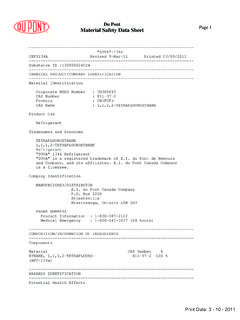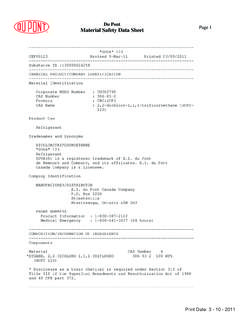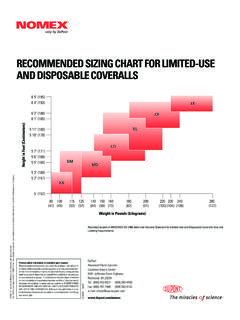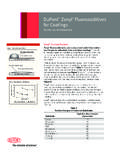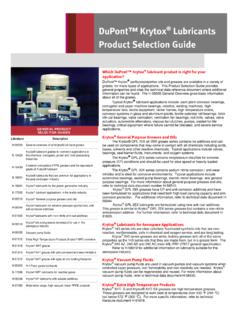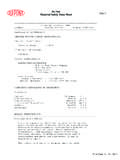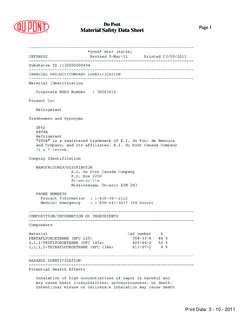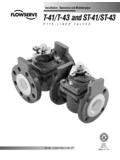Transcription of Alkylation Unit Monitoring FINAL 2008 - DuPont …
1 Alkylation unit Monitoring Presented By Jeff Caton, Staff Process Engineer Brian Racen, Staff Process Engineer Greg Troutman, Process Engineer DuPont STRATCO Clean Fuel Technology 11350 Tomahawk Creek Parkway Suite 200 Leawood, KS 66211 September 2008 Copyright 2008 DuPont STRATCO Clean Fuel Technology iTable of Contents Page Number I. INTRODUCTION ..1 II. Alkylation unit FEED Figure 1 - Typical Alkylation unit Feed Streams ..2 A. Olefin Feed ..2 1. 2. Noncondensables ..3 3. Contaminants ..3 table 1 - Sulfuric Acid Dilution a. b. Oxygenates ..5 c. Dienes ..6 d. e. Sulfur Compounds.
2 6 B. Makeup Isobutane Feed ..7 III. Alkylation unit PRODUCT STREAMS ..8 Figure 2 - Typical Alkylation unit Product A. 1. Distillation a. Insufficient Mixing ..9 b. Low Isobutane to Olefin c. High Reaction d. High levels of dienes and diluents in the feed ..9 2. Octane Results ..9 3. Reid Vapor Pressure B. Propane Product ..10 C. n-Butane Product ..10 IV. INTERNAL Alkylation RECYCLE STREAMS ..12 Figure 3 - Typical Alkylation unit Recycle Streams ..12 A. Recycle Isobutane from Deisobutanizer ..12 B. Refrigerant Recycle ..13 iiTable of Contents Page Number V. ACID STREAMS ..14 A.
3 Fresh B. Intermediate and Spent Figure 4 - Series Acid Flows ..15 C. Acid Flow Meters ..16 1. Orifice 2. Magnetic Flow Meters ..16 3. Coriolis Meters ..16 VI. ON-LINE ACID STRENGTH Monitoring ..17 A. Continuous Acid Strength Measurement ..17 Figure 5 - Typical Spent Acid Strength Trend ..17 Figure 6 - Sulfuric Acid Strength vs. Density ..19 Figure 7 - Red-Oil Adjusted Sulfuric Acid Strength vs. Density ..19 Figure 8 - Sulfuric Acid Density vs. Temperature ..20 B. On-Line Instrument Options ..21 1. Nuclear Source Density Detector [STRATCO Acid Analyzer Pre-1997] ..21 Figure 9 - STRATCO Acid Analyzer [Pre-1997]..22 2. Coriolis Meter ..23 Figure 10 - Coriolis Meter Flow Tube ..23 3. Sonic Velocity Meter.
4 25 Figure 11 - Speed of Sound in Alkylation Acid vs. Time ..25 4. NMR 5. VII. REACTION A. STRATCO ContactorTM Reactor Emulsion Monitoring ..27 1. Ratio Glass Figure 12 - Typical Contactor Reactor Ratio Glass B. On-Line Instrument Options ..30 1. Contactor Reactor Motor 2. Contactor Reactor Impeller Pressure iiiTable of Contents PageNumber 3. Coriolis Meter ..31 Figure 13 - New Ratio Glass System Configuration ..32 4. AGAR Probes ..32 5. NMR C. Contactor Reactor Temperature ..33 D. Contactor Reactor VIII. ACID A. Monitoring the Settler Figure 14 - Acid Settler Sight Glass Layout ..36 B. Continuous Acid Settler Level C. On-Line Instrument Options.
5 37 1. AGAR Probes ..38 2. Capacitance 3. Magnetic Level Gauges ..38 4. Radar Level D. Monitoring the Settler E. Controlling the Contactor Reactor Emulsion Ratio ..39 Figure 15 - Contactor Reactor/Settler Acid F. Physical Acid Carryover ..40 1. Cold 2. Acid Settler 3. Contactor Reactor Pressure 4. Contactor Reactor Tube Bundle G. Tight Emulsions ..42 Figure 16 - Acid Settler with Normal Emulsion ..43 Figure 17 - Acid Settler with Tight Emulsion ..43 IX. REFRIGERATION SYSTEM ..43 A. Suction Trap/Flash B. Compressor ..44 C. X. EFFLUENT ivTable of Contents Page Number A. Caustic/Water 1.
6 Circulation 2. Static Mixers ..46 3. Temperature ..46 4. Interface Level and Caustic/Water Addition ..47 5. Caustic Change-Outs ..47 B. Acid/Alkaline Water Wash ..47 1. Circulation 2. Static Mixer Pressure Drop ..48 3. Interface Level ..48 4. Alkaline Water Wash Temperature ..48 5. pH Level ..48 6. Alkaline Water Conductivity ..49 7. Electrostatic Precipitator Amp and Volt Readings ..49 C. Acid Wash Coalescer/Alkaline Water Wash Drum/Water Wash Coalescer ..49 1. Circulation 2. Static Mixer Pressure Drop ..50 3. Interface Level ..50 4. Alkaline Water Wash Temperature.
7 50 5. pH Level ..50 6. Alkaline Water Conductivity ..51 XI. LABORATORY SAMPLING SCHEDULE AND table 2: Laboratory Sampling Schedule ..52 table 3: DuPont Recommended Lab Methods ..53 A. Alkylation Sulfuric Acid Titration Alkylation unit Monitoring Page 1 Alkylation unit Monitoring I. INTRODUCTION Recent changes in gasoline reformulation legislation demand that alkylate producers maximize unit efficiencies at ever increasing throughput rates. This extra burden on the Alkylation process requires that refiners develop a more thorough understanding of unit performance and operating trends through a complete Monitoring and surveillance program.
8 The knowledge obtained from such a program will allow for a greater degree of plant optimization and control, ensuring that efficiencies are maintained at peak levels while unit downtime is minimized. This paper is a precursor to any consulting or unit operation enhancement program. The effectiveness of this type of program is greatly dependent upon the ability of a refiner to monitor, track, and understand normal Alkylation unit operating performance. Implementation of the basic Monitoring and troubleshooting programs outlined in this paper will improve operating efficiency and allow for a greater understanding of unit performance and trends. This will enable a refiner to increase the effectiveness of DuPont 's Alkylation consulting programs, resulting in improved alkylate quality and plant reliability.
9 DuPont continues to pursue on-line alternatives to the traditional technologies used to monitor acid strength, acid to hydrocarbon ratio, and acid settler levels. DuPont would like to be involved in any projects where refiners are seeking a greater degree of control over the critical process parameters in an Alkylation reaction zone. Alkylation unit Monitoring Page 2II. Alkylation unit FEED STREAMS Figure 1 shows a block flow diagram for an Alkylation unit . The two main feed streams, olefin feed and makeup isobutane, are highlighted. Figure 1 - Typical Alkylation unit Feed Streams ALKYLATIONREACTIONSECTIONEFFLUENT TREATINGBLOWDOWNPROPANEPURGEOLEFIN FEEDN-BUTANEPRODUCTALKYLATEPRODUCTFRESHH 2SO4 SPENTH2SO4 REFINERYSEWERDEISOBUTANIZERMAKEUP IC4 FEEDREFRIGERATIONSECTIONREFRIGERANTRECYC LEDIB OVERHEADRECYCLE IC4 A.
10 Olefin Feed The olefin feed to an Alkylation unit generally originates from a Fluid Catalytic Cracking unit (FCC) and will contain butylenes, isobutane, and possibly propylene and/or amylenes. The olefin feed is also likely to contain diluents (propane, n-butane, and n-pentane), noncondensables (ethane and hydrogen) and contaminants, which are discussed in detail on the following pages. To properly monitor feedstock quality, most refiners perform a daily gas chromatographic (GC) analysis on the olefin stream. To minimize laboratory analytical costs and GC operator time, some refineries run incomplete GC analyses, checking only for C3, C4, and C5 constituents. To properly monitor the feedstock components, the refinery should perform a complete GC analysis at least once a month.
